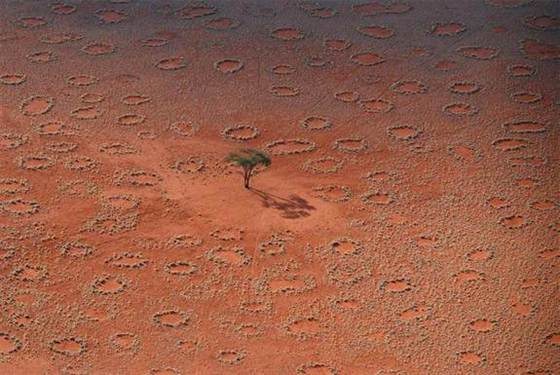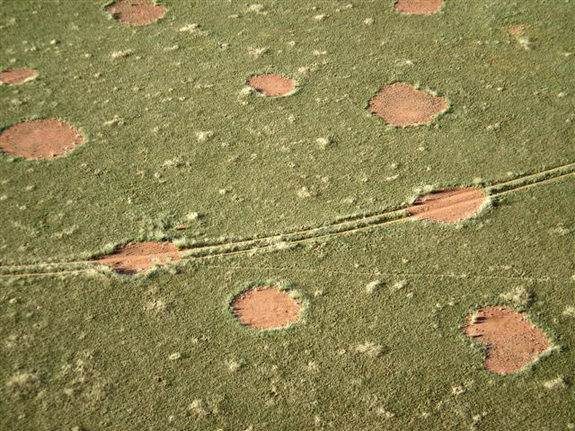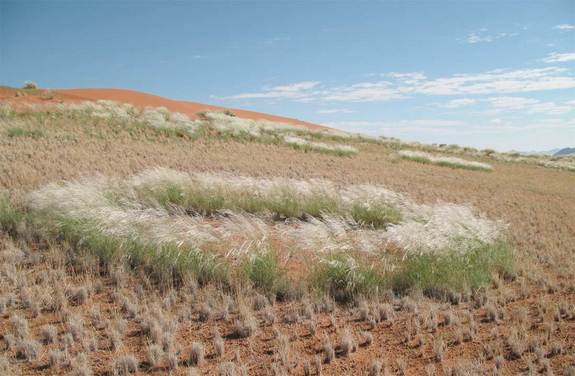New Theory Explains African Fairy Circles
This article is more than 2 years old
 While we’ve all heard of crop circles, which most people believe are the product of a hoax perpetrated by two bored Brits (though at least one scientist insists they’re real), fewer of us have heard of fairy circles. The bare circular patches in the Namib Desert grasslands in southwest Africa have long defied explanation — scientists have tossed around ideas such as ants, termites, or vegetation-unfriendly gasses in the soil. But new research indicates that the bald patches might be a product of plant competition for resources in an unfriendly climate.
While we’ve all heard of crop circles, which most people believe are the product of a hoax perpetrated by two bored Brits (though at least one scientist insists they’re real), fewer of us have heard of fairy circles. The bare circular patches in the Namib Desert grasslands in southwest Africa have long defied explanation — scientists have tossed around ideas such as ants, termites, or vegetation-unfriendly gasses in the soil. But new research indicates that the bald patches might be a product of plant competition for resources in an unfriendly climate.
As one might guess, rainfall isn’t easy to come by in the Namib Desert, and the soil doesn’t contain many nutrients. The new research suggests that the hardier grasses suck up all the water and nutrients, leaving neighboring vegetation to die. The gap formed by lack of vegetation gets bigger, and eventually water and other nutrients pool and collect there, like an oasis. Then, larger grasses and vegetation begins to grow around the pool, sucking out the water stored there, creating a fairy circle.

Unlike other possible explanations, this one “accounts for all the characteristics of fairy circles,” according to Walter Tschinkel, a biologist at Florida State University. One of those characteristics is longevity — small fairy circles have a lifespan of roughly 24 years, while the bigger ones can last for 75. In time, the plants fill the circles back in, leave indented “ghost circles” behind. The circles range from over 6-40 feet in diameter.
Tschinkel, then, rejects the theory presented this year by a University of Hamburg biologist that the circles were made by sand termites. Termite colonies are often found in the middle of these circles, which is where the soil is the wettest. Biologist Norbert Juergens suggested, then, that the termites would eat the roots, kill the grasses, and then use the water in the area, leaving them to be the thriving bullseye in a dead dartboard. Tschinkel and other biologists believe that this theory suffers from a correlation/causation problem — just because termites happen to live in fairy circles doesn’t mean they created them. The termites may, however, help maintain the circles by killing any grass that could grow in the center.
Using measurements, soil samples, and computer models, University of Colorado scientists confirmed that the “the size of the circle, the density and degree to which [fairy circles] occupy the landscape are all associated with the amount of resources available.” Researchers also found that the distribution of fairy circles is determined by rainfall — if there’s too much rain, the competition isn’t as stiff and vegetation can grow normally, but if there’s not enough rain, no vegetation wins the competition so there’s no plant border, and thus, no circles. They also believe that the spacing between fairy circles is due to resource competition between bordering vegetation.

While scientists will continue testing this theory — they admit they’d like stronger causal proof — they don’t seem to be entertaining the possibility that fairies made these circles. And you know what happens to people who don’t believe in fairies…











